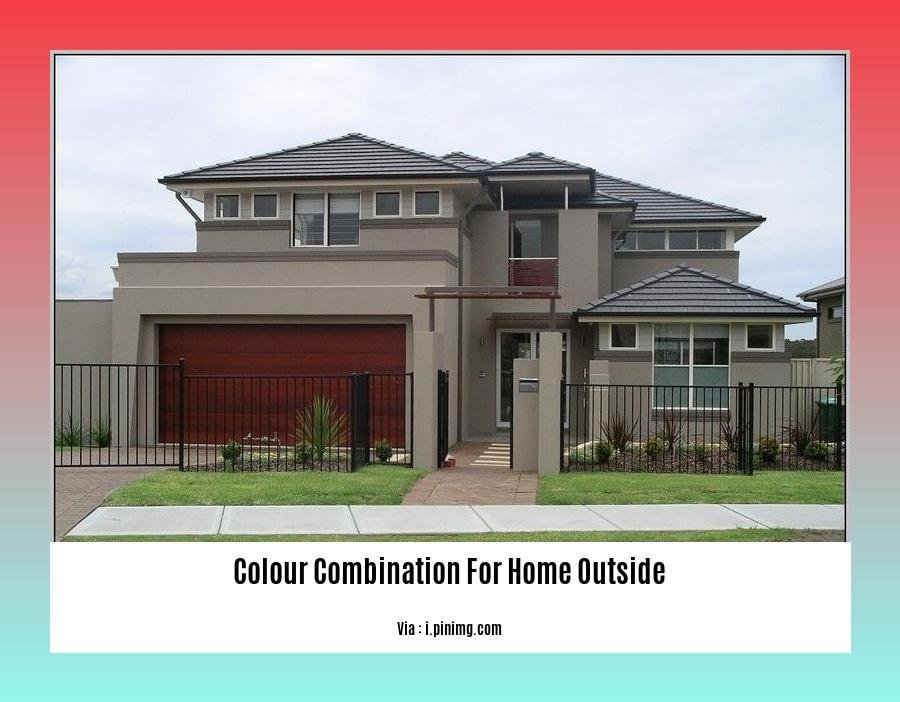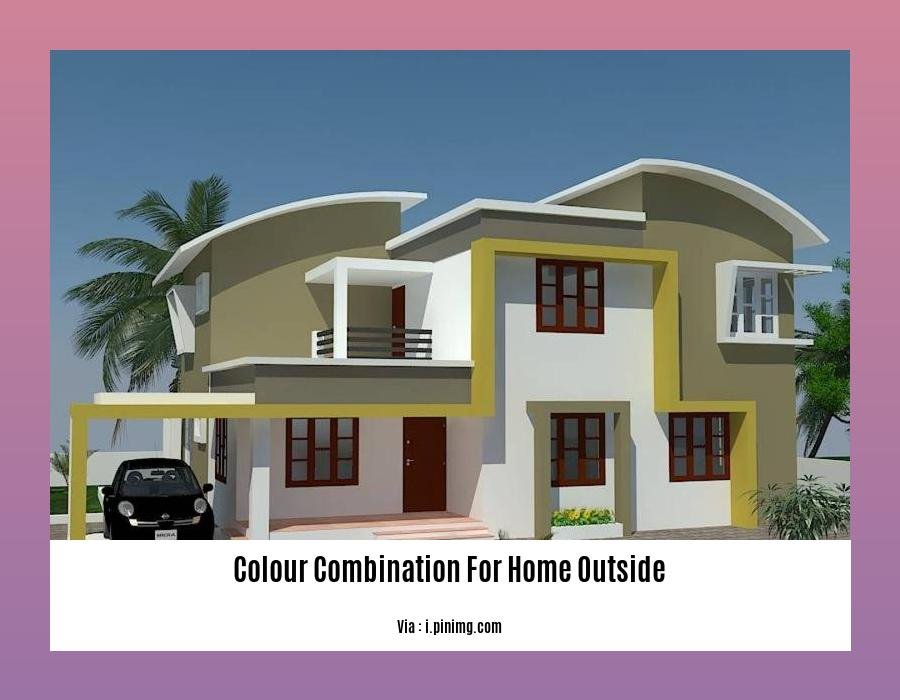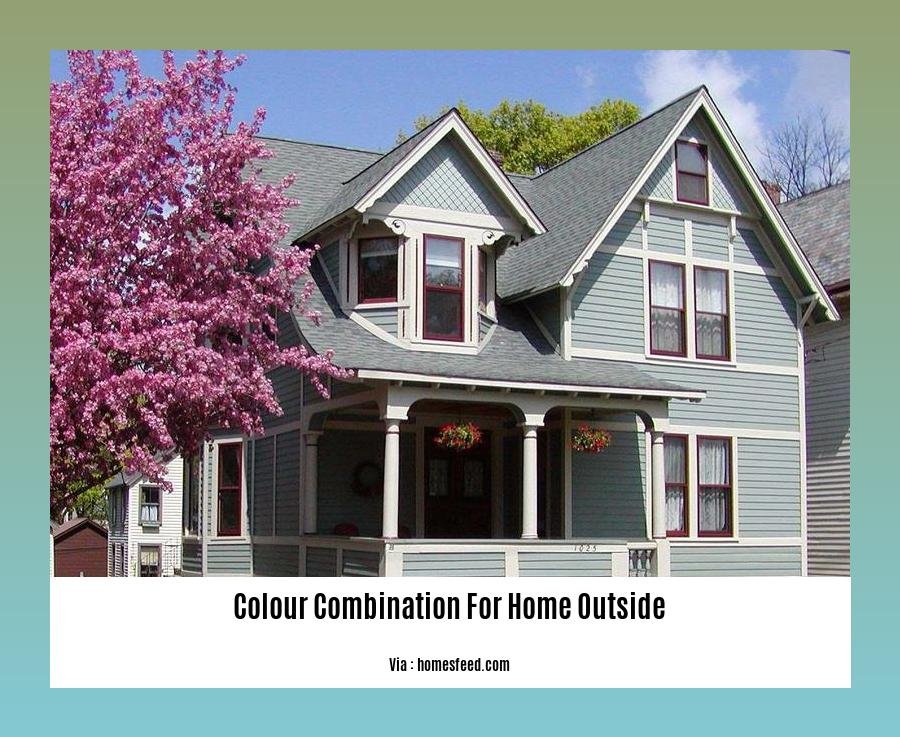Embrace the transformative power of color combinations with our comprehensive guide, [- A Guide to Colour Combination for Home Outside: Transform Your Exterior with Harmony and Style]. As seasoned home exterior design experts, we’ve dedicated years to the art of creating captivating outdoor spaces that enhance curb appeal and reflect your personal style. Discover the influence of color psychology, unravel the intricacies of color theory, and explore practical application techniques to elevate your home’s exterior with harmony and flair.
Key Takeaways:
-
Popular Indian Home Combinations:
- Grey and white
- Grey and navy blue
- Yellow and cream
-
Widely Chosen Exterior Combinations:
- Cream and brown
- White and blue
- Yellow and brown
- Grey and red
- White, gray, and brown
- White and slate grey
- Brick red, gray, and white
-
Trim Colors:
- White: Clean and crisp with many exterior colors
- Brown, black, and gray: Complementary to many color schemes
-
Accent Colors:
- Bright shades (e.g., yellow or green) enhance neutral field colors (e.g., white or gray)
Colour Combinations for Home Outside: Transform Your Exterior

Choosing the right colour combination for home outside can enhance curb appeal, reflect your personality, and create a harmonious outdoor space. Here’s a guide to help you make the best choices:
Understanding Colour Theory
Start by understanding the basics of colour theory. The colour wheel divides colours into three primary (red, yellow, blue), three secondary (green, orange, purple), and six tertiary colours (combinations of primary and secondary). Complementary colours are opposite each other on the wheel (e.g., red and green), while analogous colours are adjacent (e.g., blue, blue-green, green).
Considering Your Home’s Architecture
The architectural style of your home should influence your colour choices. For traditional homes, classic combinations like white and navy or grey and red work well. Modern homes can handle bolder colour combinations for home outside, such as yellow and cream or grey and navy blue.
Coordinating with Your Surroundings
Consider the colours of your neighbours’ homes, as well as the natural elements in your yard. For a cohesive look, choose colours that complement these surroundings. For example, a house surrounded by lush greenery might look inviting in a shade of yellow or cream.
Choosing Trim and Accent Colours
Trim colours provide contrast and definition to your home’s exterior. White is a versatile choice that goes with most colours. For a bolder look, consider shades of brown, black, or grey. Accent colours add pops of colour, such as yellow or green, to create interest against a neutral field colour like white or grey.
Recommended Colour Combinations for Home Outside
Here are some popular and timeless colour combinations for home outside:
- Cream and brown
- White and blue
- Yellow and cream
- Grey and navy blue
- Grey and red
- White, grey, and brown
- Brick red, grey, and white
- White and slate grey
Conclusion
Choosing the perfect colour combination for home outside is a rewarding experience that can transform your exterior’s aesthetic. By following these guidelines and considering your personal preferences, you can create a harmonious and inviting outdoor space that reflects your style.
Looking for the most budget-friendly prefabricated homes in the UK? For a list of the most affordable prefab homes, click here: cheapest prefab homes uk
Wondering about the most essential cleaning items you should have at home? For a handy checklist of home cleaning essentials, click here: cleaning items list for home
Unsure about the best color scheme for your home? For inspiration and guidance on choosing the perfect colors for your home, click here: color guide for house
Evoking Emotions Through Exterior Color

When selecting colors for your home’s exterior, consider how different hues evoke specific emotions. Colors have the power to create a welcoming ambiance and reflect your personality and style. Here’s how to harness their emotional impact:
Warm Colors:
- Red: Exudes energy, excitement, and warmth. Use it sparingly as an accent.
- Orange: Conveys happiness, optimism, and creativity.
- Yellow: Inspires joy, warmth, and a sense of home.
Cool Colors:
- Blue: Creates a sense of calm, serenity, and trust.
- Green: Represents tranquility, growth, and stability.
- Purple: Evokes mystery, royalty, and sophistication.
Neutral Colors:
- White: A classic that evokes purity, cleanliness, and spaciousness.
- Gray: Provides a sophisticated backdrop for bolder colors.
- Black: A dramatic choice that adds depth and elegance.
Key Takeaways:
- Understand the emotional associations of different colors.
- Use warm colors for energy and excitement, and cool colors for calm and serenity.
- Use neutral colors as a backdrop for bolder shades.
- Experiment with different hues to create the desired mood.
Relevant Sources:
- Psychology of Color in Home Design
- The Emotional Impact of Color on Home Exteriors
Reflecting Personality and Style
Embracing Color Psychology to Create a Home that Speaks to You
Your home’s exterior color isn’t just about aesthetics; it’s an expression of your personality and style. Colors evoke emotions, set the tone for your home’s ambiance, and can even influence curb appeal.
Matching Your Exterior to Your Architectural Style and Design Goals
Consider the architectural details of your home when selecting colors. Bold, contrasting hues can highlight architectural elements like columns or bay windows, while a monochromatic scheme can accentuate minimalist lines. Choose colors that complement the style of your home, whether it’s classic and traditional or modern and contemporary.
Creating a Cohesive Look with Your Surroundings
Notice the colors of neighboring homes and surrounding natural features like trees or water. Choose hues that harmonize with your surroundings, creating a cohesive and inviting neighborhood.
Experimenting with Complimentary and Contrasting Colors
Explore the power of color theory to create visually stunning exteriors. Use complementary colors for a vibrant contrast, such as blue and orange, or analogous colors for a serene flow, such as green, yellow, and blue.
Infusing Personal Touches
Don’t be afraid to incorporate pops of color that reflect your personality. Whether it’s a bright front door, contrasting shutters, or a colorful accent wall, these touches add character and a sense of individuality to your home.
Key Takeaways:
- Colors evoke emotions and set the ambiance of your home.
- Matching exterior colors to architectural styles and surroundings creates harmony.
- Experiment with color theory to achieve stunning visual effects.
- Incorporate personal touches through pops of color that reflect your personality.
- Consider the psychology of color to create a home that truly speaks to you.
[Citation]
Practical Considerations for Exterior Paint Application
When embarking on your home painting adventure, these thoughtful considerations will help you achieve a harmonious and visually appealing exterior:
Environmental Factors:
- Consider the climate: Temperature extremes, UV exposure, and humidity can affect paint performance.
- Think about sunlight: Exposure to direct sunlight can impact the fading rate of colors.
Surface Preparation:
– Clean the surface: Remove dirt, mildew, and debris to ensure paint adheres properly.
– Sanding: For smooth surfaces, lightly sand to enhance paint adhesion.
– Priming: Apply primer to create a uniform base and improve paint coverage.
Color Harmony:
- Choose a color scheme: Use complementary or analogous colors to create harmony.
- Balance primary, secondary, and accent colors: Avoid overwhelming your exterior with too many bold hues.
- Consider the architectural style: Match colors to the style of your home for a cohesive look.
Quality Counts:
- Invest in high-quality paint: Opt for durable paint resistant to fading, peeling, and cracking.
- Professional application: For complex exteriors or desired precision, consider hiring a professional painter.
Maintenance Tips:
- Regular inspections: Check your exterior regularly for signs of wear and tear.
- Clean and touch up: Address any chips or fading promptly to prevent further damage.
- Repaint when necessary: Over time, paint will fade and deteriorate, requiring a fresh coat.
Key Takeaways:
- Plan your color scheme thoughtfully, considering environmental factors and your home’s architectural style.
- Proper surface preparation ensures paint adheres well and lasts longer.
- Choose high-quality paint and application methods to maximize durability.
- Regularly inspect and maintain your exterior to keep it looking its best.
Relevant Sources:
- Painting Your Home’s Exterior: A Step-by-Step Guide
- Exterior Painting Tips from the Pros
FAQ
Q1: What are some popular color combinations for Indian homes?
A1: Popular color combinations include grey and white, grey and navy blue, yellow and cream, cream and brown, white and blue, yellow and brown, and grey and red.
Q2: How do I choose a color scheme that complements my home’s architectural features?
A2: Consider highlighting architectural elements with contrasting colors, such as socles, bay windows, and canopies.
Q3: What are some tips for balancing primary, complementary, and accent colors?
A3: Use three colors for depth and visual interest. Balance primary colors with complementary colors and accent colors. Consider using black windows for a bold statement.
Q4: How can I incorporate natural surroundings into my exterior color scheme?
A4: Draw inspiration from the colors found in the surrounding landscape and vegetation. This can create a cohesive and harmonious look.
Q5: What should I consider when choosing a color combination for my home’s exterior?
A5: Factors to consider include architectural features, location, climate, sunlight exposure, personal preferences, and neighborhood compatibility.
- Greenhouse Storage Shed Combos: Your Guide to Combining Growing and Storage - April 21, 2025
- Greenhouse Shed Combo: Design, Build & Grow Year-Round - April 21, 2025
- Gingham vs. Plaid: What’s the Difference? A Complete Guide - April 21, 2025










